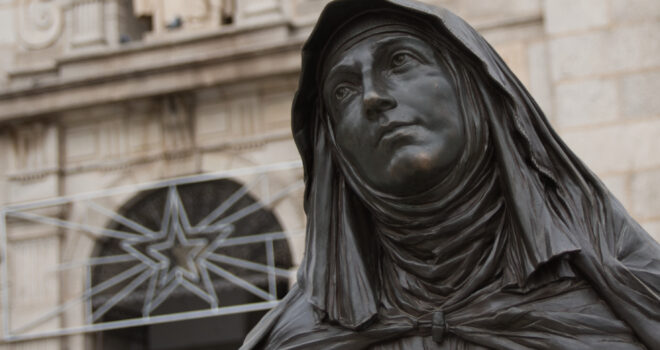Saint Teresa of Avila was a born leader, but her strengths were made perfect in the crucible of obedience.
St. Teresa joined the Carmelite Order at a time when the order had become somewhat lax. There are a variety of reasons for this, including the aftermath of the Black Death of the 14th century. In Teresa’s Spain, constant war and colonization decimated the male population and left large numbers of women unable to find a husband. Many simply joined a religious order, not because they felt a vocation, but as a backup plan.
St. Teresa spent nearly two decades as a nun living in a somewhat lax house in her hometown of Avila, Spain, with little or no compunction about this laxity. St. Teresa simply followed the relaxed rule of her order and obeyed her superiors. This was commendable.
But upon reading the Confessions of Saint Augustine, St. Teresa began to experience what she later called a “second conversion,” which included a desire to live out the earlier, much more demanding form of the Carmelite rule like the saints she so venerated. In this great ambition she quickly found that she was not alone, as other sisters told her they wanted to strive after holiness in a more intense way.
To us St. Teresa’s goal of returning to the roots of her order sounds like a perfectly harmless and laudable goal, but it was not shared by all. This initiative was largely taken as a criticism by those in charge of the order. St. Teresa found resistance to her vision not only from the outside world but most intensely of all from her fellow Carmelites.
In Avila, everyone considered her idea ridiculous and some thought that Teresa was arrogant for such ambitions. And of course there was, as always, the question of how to pay for it. Avila already had a great number of religious houses and both the clergy and the state alike were convinced that it could not afford another. Teresa’s idea not only seemed like a personal affront to her fellow nuns but a threat to the finances of the community.
Priests in Avila were so indignant with St. Teresa that her closest financial benefactress was denied absolution unless she would repent of her association with her.[1] Carmelite fathers even publicly preached against St. Teresa in their homilies. When St. Teresa sat through one such homily, she did not become angry or upset, but rather is recorded as “laughing with great peace.”[2]
St. Teresa obeyed her confessor when he told her not to go through with her idea—even though she had many visions of Christ urging her to complete this work. Eventually, her confessor died, and she got a new one who encouraged her reform.
When the Convent of San Jose was finally complete, St. Teresa could finally live out her vocation as she desired. She said that it was the most peaceful period of her life. But after four years, she was called by Christ to found more houses of religion, and she met with even more opposition.
In 1571, the pope’s representative in Spain ordered St. Teresa to stop founding convents, go back to her original monastery of Encarnacion in Avila, and to stay there. This would have been enough of a shock, but to make matters worse, he made her the prioress of her former convent. Since she had left, it had only become more lax.
Many of the nuns at Encarnacion were the same ones who had denounced Teresa or calumniated her a decade before. Some nuns even attempted to physically block St. Teresa from entering the building and shrieked at her as she approached.[3]
St. Teresa remained calm. When it came time for her to take her seat in chapter, St. Teresa put a statue of Our Lady in the prioress’ seat, and sat at its feet.[4] She told the nuns that she did not want to be prioress, but was only taking office under obedience. Speaking to each individually, she said she agreed that she was unworthy.[5]
The new prioress did not impose her rules on the nuns, but simply required them to follow their own rule. Not only did the nuns become holy, but they grew to love St. Teresa, and tried to re-elect her when her term ended.
When she was given a new superior who was 30 years younger than she was and only a Carmelite for six months, she swore obedience happily. When his orders contradicted visions she had of Our Lord, she obeyed her superior, and not the visions. Further visions praised her for doing so.
Opponents of St. Teresa denounced her to the Spanish Inquisition on several occasions, but this proved to be a blessing in disguise, as she won key supporters among the episcopal hierarchy. During her interview with the Inquisition, St. Teresa was recorded to smile and even crack jokes.
In 1577, the papal nuncio died and was replaced with a bishop who was hostile to St. Teresa. But his efforts to restrict St. Teresa’s reform only won sympathy for her among the Royal Court of Philip II. Finally a Count scolded the bishop, who demanded an apology from King Philip. The King, who by then was a personal friend and dogged supporter of St. Teresa, refused.
In time, the Count apologized, and the nuncio’s heart softened toward St. Teresa. A commission advised the nuncio to give St. Teresa’s Discalced more independence from the Calced Carmelites who had so opposed them. A year later, Pope Gregory XIII gave them their own province.[6] In 1593, Clement VIII finally made the Discalced Carmelites a separate order with a separate Prior General.[7]
The saint’s dying words were an affirmation of obedience: “I am a daughter of the Church.”[8] In 1622, just 40 years after her death, Pope Gregory XV canonized St. Teresa.[9] In 1970, Pope Paul VI declared St. Teresa as the first female Doctor of the Church.[10]
[1] https://www.ewtn.com/catholicism/library/st-teresa-of-avila-5894
[2] Vida, footnote 259. cf. [cf. P. Silverio, I, 270, n. Cf. ch. XXIII, para.5 “con gran paz se estaba riendo”
[3] Walsh 389 citing Yepes lib 2 capit 24
[4] Walsh 392 citing Yepes lib 2 Cap 25 and Ribera lib 3 cap 1
[5] Walsh 392 citing Yepes lib 2 Cap 25 and Ribera lib 3 cap 1
[6] Walsh 551
[7] Carmelites, Discalced | Encyclopedia.com
[8] Walsh 579
[9] Carmelites | Carmelitani | Carmelitas :: O.Carm :: The Memorable Canonization of 1622 (ocarm.org)
[10] Carmelites | Carmelitani | Carmelitas :: O.Carm :: Saint Teresa of Ávila Doctor of the Church (ocarm.org)
Image by Molinari on Shutterstock
This article was adapted from Alec’s new book, Persecuted from Within, which is available from Sophia Institute Press October 17, 2023.













